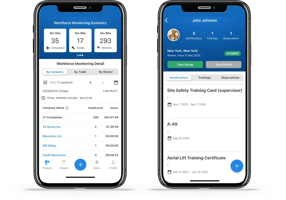Access control technology, such as the innovative FCA platform, simplifies the tasks of...
Keeping Construction Sites Safe: The Importance of Access Control
Construction sites are a hub of activity, with workers and heavy machinery moving about well-designed pathways. However, amidst all the hustle-bustle, one critical aspect that must never be overlooked is controlling access to the jobsite. Ensuring only authorized personnel have access to construction sites maintains safety standards and prevents accidents. As many dangers are present on a construction site, it’s important to have a robust access control technology plan in place. FCA’s technology allows its clients to know who has access to the site and when so you can help to mitigate some of the risks associated with construction work.
In this blog post, we will delve into the importance of access control technologies and how Field Control Analytics’ suite of services contribute to a successful project outcome. So buckle up as we take you on an insightful journey through the world of construction site perimeter security!
Introduction to Access Control in Construction
There are two main types of access control in construction: physical access control and electronic access control. Physical access control involves using physical barriers like temporary fences and security guards or full-height turnstiles to restrict access to the site. Electronic access control relies on technology like FCA’s mobile app and geofencing or QR codes to grant or deny entry.
There are many reasons why you might want to control access on a construction site. With FCA’s technology it can enable a client to limit the number of people who have access to potentially dangerous areas. It keeps the public from wandering onto an active site especially after-hours. Furthermore, controlling site access helps to ensure that only those who absolutely need to be on site gain access, reducing the risk of accidents occurring.
Through FCA’s access control technologies, the system can be used to track labor hours worked on the jobsite. This information can be valuable for managing contractor payroll and ensuring that employees are paid for the hours they’ve actually worked. Additionally, it can help you to identify patterns of contractor behavior and bad actors that significantly inflate labor costs and overall project costs.
Advantages of Access Control Technologies
In order to effectively control access to a construction site, you will need to implement some type of system that tracks who comes and goes. This is where FCA exemplifies their twenty year experience as the industry leader in the construction sector. Through FCA this could be as simple as issuing RFID badges to employees and contractors or as tech savvy as workers using an electronic badge on their phone to open turnstiles or check themselves into and out of the worksite.
With FCA’s technology, not only are you ensured only authorized personnel have access to the site, you received added value and peace-of-mind that your equipment and materials are safe and secure.
FCA’s access control technologies system can also help a project manage safety risks more effectively. By knowing who is onsite and where they are supposed to be, you can help to prevent accidents from happening. For example, if there is a dangerous area of the construction site that only authorized personnel should enter, FCA’s access control security system can ensure that unauthorized individuals do not gain access and put themselves at risk.
Types of Access Control Security Systems (e.g., card readers, biometric scanners, etc)
FCA’s RFID card readers and electronic badges on the mobile phone are the most common type of access control technologies system. They can be used to control access to any type of construction site. RFID Card readers work by reading a card that is placed near the reader. The card contains information about the person who is trying to gain access to the site.
Biometric scanners are another type of access control security system used to keep a construction site safe. Biometric scanners work by reading the unique physical characteristics of a person, such as their face. This information is then used to verify that the person is authorized to enter the site. Biometric scanners are often used as the dual layer of authentication as individual verification to enter a jobsite; the first layer being valid badge or identification.
No matter what type of system is used, it is important that construction sites have some form of access control in place in order to keep workers safe and prevent unauthorized individuals from gaining entry.
Conclusion
FCA’s access control technologies are an essential measure for keeping construction sites safe. By using access control systems to limit the number of people who have access to your site, you can ensure that only those with proper authorization are able to enter and that any unauthorized personnel will be spotted quickly. With the help of FCA systems in place, construction sites can remain secure and accidents can be prevented more easily.


.png?height=200&name=Why%20FCA%20(LinkedIn%20Post).png)
